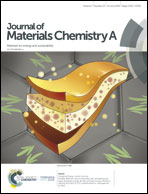Hierarchical CsPbBr3 nanocrystal-decorated ZnO nanowire/macroporous graphene hybrids for enhancing charge separation and photocatalytic CO2 reduction†
Abstract
Solar-driven CO2 conversion for chemical fuel production has been regarded as an effective strategy to alleviate environmental and energy issues. In this study, we constructed a novel composite catalyst film, in which CsPbBr3 nanocrystals (NCs) were loaded on a hierarchical branched ZnO nanowire (BZNW)/macroporous graphene scaffold (CsPbBr3 NC/BZNW/MRGO). This well-designed multi-dimensional architecture rationally integrated the excellent visible-light absorption capability of CsPbBr3 NCs, and fast charge transport and improved CO2 capture ability afforded by ZnO nanowire-branched macroporous graphene. Due to this favorable synergistic effect, a boosted photocatalytic performance was achieved with a photoelectron consumption rate of 52.02 μmol gcat−1 h−1 under visible light irradiation, which is 4.98 and 1.65 times higher than that of CsPbBr3 NC (10.44 μmol gcat−1 h−1) and CsPbBr3 NC/MRGO (31.52 μmol gcat−1 h−1), respectively. Furthermore, desirable CH4 selectivity of up to 96.7% was achieved.



 Please wait while we load your content...
Please wait while we load your content...